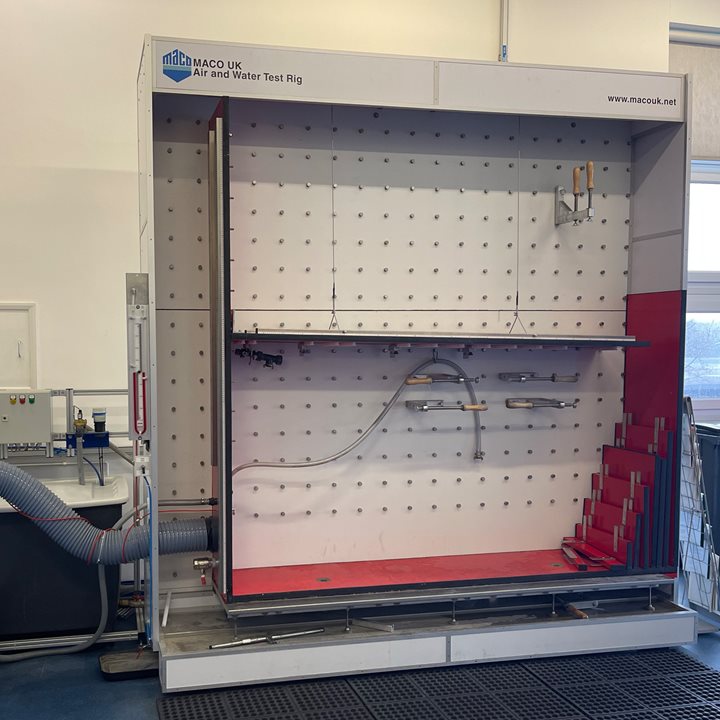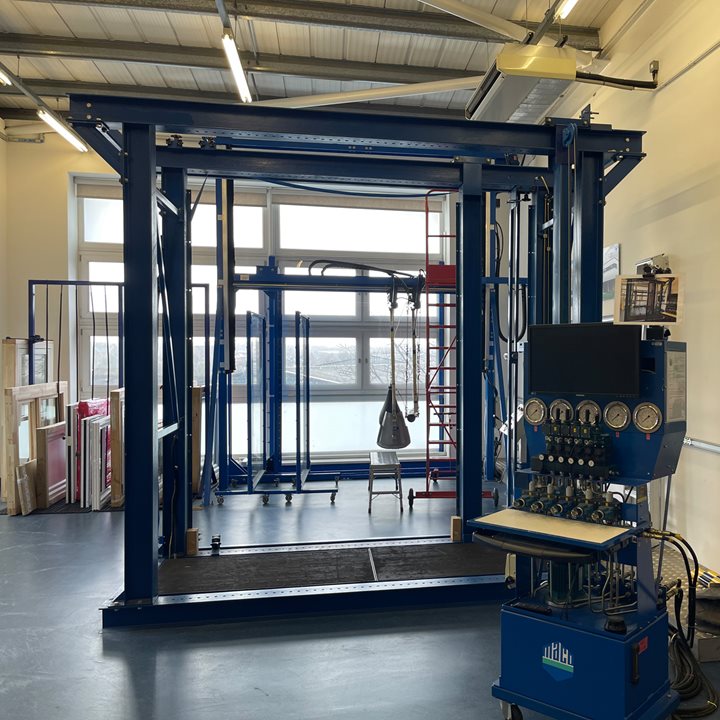Purpose Built Indicative Test House
With our in-house testing facilities, MACO UK is able to supply our customers with indicative testing, wherein test findings and constructive feedback are provided. This way, before the product is tested at an accredited test centre, the customer can make any necessary modifications and feel confident that the testing will be successful. Additionally, MACO UK allows our clients to demonstrate Document Q (The building Regulations 2010: Security – Dwellings).
Our Facilities

Indicative Air & Water Testing
2100mm Width (including sub frame)
2100mm Height (including sub frame)

Indicative Security Testing
2100mm Width(including sub frame)
2100mm Height (including sub frame)
BS 6375 Performance of windows and doors
BS EN 12207 Windows and doors – Air Permeability
The specimen shall be tested in accordance with BS EN 1026 and the test shall be conducted with both positive and negative pressures. The test result, defined as the numerical average of the positive and negative air permeability values (m3/h) at each pressure step, shall be expressed and classified in accordance with BS EN 12207.
The air flow passing through the specimen, at each pressure difference applied in accordance with BS EN 1026, shall be expressed as an average leakage rate per m length of opening joint visible on the inner face of the specimen and average leakage per m2 of window or door area.
BS EN 12208 Windows and doors – Watertightness
The specimen shall be tested in accordance with BS EN 1027, test procedure A and classified in accordance with BS EN 12208. The test specimen is subjected to a 15 minutes soak before any pressure is applied. The pressure is initially starts with 50Pa and goes up by 50Pa until it hits 450Pa where it jumps to 600Pa. The aim of this testing is to determine when water penetration (continuous or repeated wetting of the internal surface of the test specimen or parts which are not designed to be wetted when water drains to external face) occurs which will output a classification accordingly.
BS EN 12210 Windows and doors – Resistance to wind load
The specimen shall be tested in accordance with BS EN 12211 and classified in accordance with BS EN 12210. For the purpose of the tests, three sets of test pressure are defined:
- P1 applied to measure the deflection of parts of the test specimen;
- P2 pulsating pressure applied for 50 cycles to assess performance under repeated with loads; and
- P3 applied to assess the safety of the specimen under extreme conditions.
The principles of the test is to see the application of defined series of positive and negative test pressures at which measurements and inspections are made to assess relative frontal deflection and resistance to damage from wind loads.
BS EN 12046-2:2000 Operating Forces - Doors
All test specimen is measured for operating force to ensure that the handle operating force is within British Standards requirement.
BS EN 12046-1:2020 Operating Forces - Windows
All test specimen is measured for operating force to ensure that the handle operating force is within British Standards requirement.
PAS 24 Security Testing
PAS 24: 2022 Enhanced Security Performance Requirements for Doorsets and Windows in the UK – Doorset and windows intended to offer a level of security suitable for dwellings and other building exposed to comparable risk
Manual Cutting Test (Door Specific)
The target of this test is to attempt to gain entry by generating an aperture in the infill panel or fabric of the door leaf. Glass shall not be subjected to this test. Only one tool shall be used at any one time. Methods including, but no limited to, cutting and gouging, shall be used. when using a tool to strike the infill panel or fabric of the door leaf, the impact point of tool to strike the infill panel or fabric of the door leaf, the impact point of the tool shall not travel more 100mm, thus controlling impact force. The test shall be directed at the surface and core of the infill panel or fabric of the door leaf from the exterior face of doorset for a period to not more than 3 minutes.
Manual Check Test
The objective of the manual check test is to explore the possibility that there are weaknesses and vulnerabilities in the product that are not covered in the standard loading cases. The manual check test is carried out from the exterior face of the sample and conducted with full knowledge of the sample’s construction and hardware details.
Manipulation Test
The objective of this test is to establish that there is no inherent vulnerability in the design which from the outside, would permit entry by the hardware being operated, released or disengaged. The test engineer shall have detailed knowledge of the sample and the hardware installed (for example the location and direction of travel of all locking points).
Mechanical Loading Test
The objective of the mechanical loading test is to assess whether the sample is capable of withstanding a specified sequence of loading without creating an entry.
For doorset the loading shall consist of an application of a 1.5kN load which is maintained until a 4.5 kN load has been applied and removed.
For windows the loading consists of an application of 1 kN load which is maintained until 3 kN load has been applied and removed.
Soft Body Impact Test (Door Specific)
The objective of this test is to assess the doorset’s resistance to impacts using a soft body striking the lead between 0.8 meters and 1.7 meters above floor level.
Hard Body Impact Test (Door Specific)
The objective of this test is to assess the hardware, infill medium and its retention system to hard body impact.
Infill Manual Test
The target of this test is to attempt to remove gaskets, beads, security devices (if applicable) and the infill medium from the exterior face of the glazing system for a period of 3 minutes.
Infill Mechanical Test
The target of this test is to remove the glazing unit by applying a load of 2.0 kN to the exterior face of the infill progressive and without shock to every corner of each infill medium starting from the top left corner and working clockwise in turn and in a direction towards the inside, over a period of between 10 second and 20 second and within 5° perpendicular to the plane, and maintain until it has been held for 8 second to 12 second.
What Can We Test
- Single Sash Casement Windows
- Double Sash Casement Windows
- Single Sash Tilt and Turn Windows
- Double Sash Tilt and Turn Windows
- Single Entrance Doors
- Double Door Sets
- Patio Door Sets
These products are not limited by material within our testing capabilities, meaning we can test them across all material types which include:
- PVCU
- TIMBER
- ALUMINIUM
- COMPOSITES